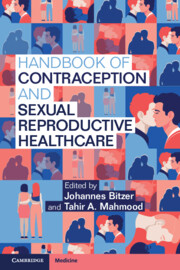Book contents
- Handbook of Contraception and Sexual Reproductive Healthcare
- Handbook of Contraception and Sexual Reproductive Healthcare
- Copyright page
- Dedication
- Contents
- About the Authors
- Contributors
- Preface
- Section 1 Scientific Basis of Contraception and Family Planning
- Section 2 Methods of Contraception
- Section 3 Contraception and Medical Conditions
- Chapter 16 Contraception for Cancer Patients
- Chapter 17 Benign Breast Disease, and Benign Uterine and Ovarian Conditions
- Chapter 18 Cardiovascular Disease and Contraception
- Chapter 19 Respiratory Diseases
- Chapter 20 Renal Diseases
- Chapter 21 Contraception for Obese Women
- Chapter 22 Contraception and HIV
- Chapter 23 Neurological and Psychiatric Disorders
- Chapter 24 Contraception for Women with Immunosuppressive Conditions
- Chapter 25 Previous Organ Transplant
- Chapter 26 Previous Bariatric Surgery
- Chapter 27 Systemic Lupus Erythematosus
- Chapter 28 Contraception for Disabled People
- Chapter 29 Diabetes (Type 1 and 2) and Gestational Diabetes Mellitus
- Chapter 30 Thyroid Dysfunction
- Chapter 31 Polycystic Ovarian Disease
- Chapter 32 Liver Disease
- Chapter 33 Inflammatory Bowel Disease
- Chapter 34 Inherited Blood Disorders (Sickle Cell Disease, Thalassaemia, etc.)
- Chapter 35 Contraception for LGBT
- Chapter 36 Contraception for Women with Special Needs: Life Cycle Approach to Contraception and Sexual and Reproductive Healthcare
- Chapter 37 Contraception and Drug Interaction
- Section 4 Subfertility
- Section 5 Termination of Pregnancy
- Section 6 Sexually Transmitted Diseases and Other Vulvovaginal and Urogenital Infections
- Section 7 Sexual Health
- Section 8 Cervical Cancer Screening
- Section 9 Standards of Care for Sexual and Reproductive Healthcare Services
- Index
- References
Chapter 28 - Contraception for Disabled People
from Section 3 - Contraception and Medical Conditions
Published online by Cambridge University Press: 25 March 2022
- Handbook of Contraception and Sexual Reproductive Healthcare
- Handbook of Contraception and Sexual Reproductive Healthcare
- Copyright page
- Dedication
- Contents
- About the Authors
- Contributors
- Preface
- Section 1 Scientific Basis of Contraception and Family Planning
- Section 2 Methods of Contraception
- Section 3 Contraception and Medical Conditions
- Chapter 16 Contraception for Cancer Patients
- Chapter 17 Benign Breast Disease, and Benign Uterine and Ovarian Conditions
- Chapter 18 Cardiovascular Disease and Contraception
- Chapter 19 Respiratory Diseases
- Chapter 20 Renal Diseases
- Chapter 21 Contraception for Obese Women
- Chapter 22 Contraception and HIV
- Chapter 23 Neurological and Psychiatric Disorders
- Chapter 24 Contraception for Women with Immunosuppressive Conditions
- Chapter 25 Previous Organ Transplant
- Chapter 26 Previous Bariatric Surgery
- Chapter 27 Systemic Lupus Erythematosus
- Chapter 28 Contraception for Disabled People
- Chapter 29 Diabetes (Type 1 and 2) and Gestational Diabetes Mellitus
- Chapter 30 Thyroid Dysfunction
- Chapter 31 Polycystic Ovarian Disease
- Chapter 32 Liver Disease
- Chapter 33 Inflammatory Bowel Disease
- Chapter 34 Inherited Blood Disorders (Sickle Cell Disease, Thalassaemia, etc.)
- Chapter 35 Contraception for LGBT
- Chapter 36 Contraception for Women with Special Needs: Life Cycle Approach to Contraception and Sexual and Reproductive Healthcare
- Chapter 37 Contraception and Drug Interaction
- Section 4 Subfertility
- Section 5 Termination of Pregnancy
- Section 6 Sexually Transmitted Diseases and Other Vulvovaginal and Urogenital Infections
- Section 7 Sexual Health
- Section 8 Cervical Cancer Screening
- Section 9 Standards of Care for Sexual and Reproductive Healthcare Services
- Index
- References
Summary
Prevalence of disease, risks, impact on fertility, Medical Eligibility Criteria 3 and 4, advantages, disadvantages, special considerations
- Type
- Chapter
- Information
- Handbook of Contraception and Sexual Reproductive Healthcare , pp. 174 - 177Publisher: Cambridge University PressPrint publication year: 2022

